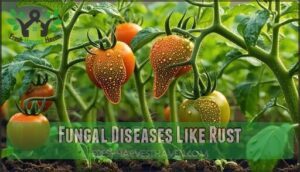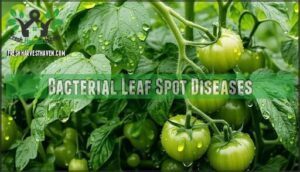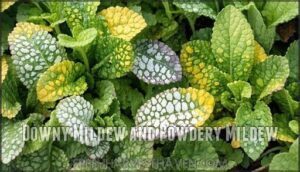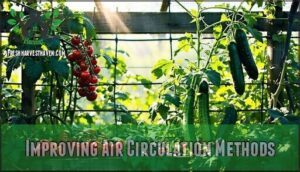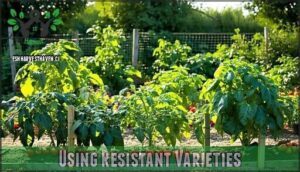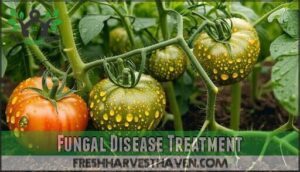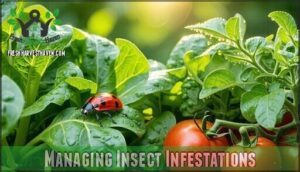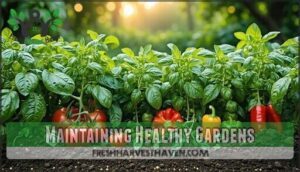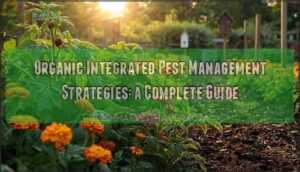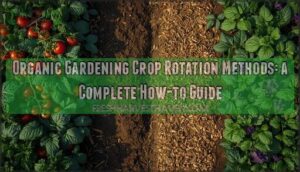This site is supported by our readers. We may earn a commission, at no cost to you, if you purchase through links.
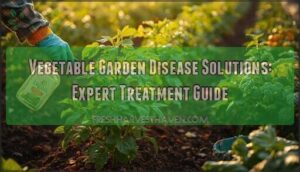
Start with proper spacing for air circulation, water at soil level to keep leaves dry, and choose disease-resistant varieties when possible.
For fungal issues like powdery mildew, apply organic copper fungicides or neem oil. Remove infected plant material immediately to prevent spread.
Bacterial diseases require removing affected plants and improving drainage. Viral problems can’t be cured, so focus on controlling insect vectors that spread them.
Healthy soil with good drainage prevents many root diseases from taking hold. Success comes from combining multiple strategies rather than relying on single treatments.
Table Of Contents
- Key Takeaways
- Common Garden Diseases
- Preventing Garden Diseases
- Fungal Disease Treatment
- Managing Insect Infestations
- Maintaining Healthy Gardens
- Frequently Asked Questions (FAQs)
- How do you prevent diseases in a vegetable garden?
- Are garden diseases curable?
- How do you treat a plant disease in a greenhouse?
- What are the most common garden diseases?
- How do you take care of a diseased plant?
- What are the most common problems in a vegetable garden?
- How to control vegetable disease?
- What is the best way to solve plant diseases?
- How do you prevent garden diseases?
- Are there any natural products that will help stop vertigo?
- Conclusion
Key Takeaways
- You’ll prevent most diseases by focusing on proper plant spacing, watering at soil level, and choosing disease-resistant varieties – these three prevention strategies stop problems before they start and save you time and money compared to treating infections later.
- Act fast when you spot disease symptoms by removing infected plants immediately and applying organic treatments like copper fungicides or neem oil – quick action prevents spread and gives you the best chance of saving your remaining crops.
- You’ll get better results by combining multiple strategies rather than relying on single treatments – use prevention, early detection, targeted treatments, and healthy soil practices together for comprehensive disease management.
- Focus on building healthy soil with good drainage and practice crop rotation – strong soil prevents root diseases, while rotating crops yearly breaks disease cycles that can devastate your garden season after season.
Common Garden Diseases
Your vegetable garden faces threats from several common diseases that can quickly damage or destroy your crops.
Understanding these diseases helps you spot problems early and take action before they spread throughout your garden, which is a complete concept to grasp for gardening success.
Fungal Diseases Like Rust
Why does rust spread so fast in your garden? This sneaky fungal disease produces orange-red spores that travel on wind and water.
Rust Identification starts with spotting these telltale signs:
- Orange, yellow, or brown powdery spots on leaves
- Host Plants like beans, tomatoes, and leafy greens most affected
- Environmental Factors include warm, humid conditions
- Spore Dispersal happens rapidly through air currents
- Rust Prevention requires proper spacing and dry leaves
Commercial fungicides work best when applied early. To combat this issue, consider using biological control methods. Focus on improving airflow between plants to reduce humidity levels that encourage infection.
Bacterial Leaf Spot Diseases
While fungal diseases attack through moisture, bacterial leaf spot diseases strike through a different pathway.
You’ll spot bacterial spread when small, water-soaked lesions appear on leaves, quickly turning brown or black.
These spots often have yellow halos and create a "shot-hole" appearance as tissue dies.
Leaf spot ID becomes easier when you know bacteria enter through wounds during warm, humid weather.
Affected vegetables like tomatoes, peppers, and beans show symptoms within days of infection.
Treatment timing matters most.
Apply preventative sprays containing copper before symptoms appear.
Once you see spots, remove infected plants immediately to stop bacterial disease treatment from becoming overwhelming.
The disease is often found in humid or wet conditions.
Vegetable garden diseases caused by bacteria spread rapidly through splashing water, so avoid overhead watering completely.
Viral Diseases Like Mosaic Virus
Over 200 vegetable species face mosaic virus threats, causing mottled leaves and stunted growth.
Insect vectors like aphids spread these viral infections rapidly between plants.
Virus identification requires spotting disease symptoms: yellow-green patterns and distorted foliage.
No cure exists—immediate eradication methods include removing infected plants completely.
Prevention works best: choose disease resistant plants and practice viral disease prevention through tool sanitation.
Downy Mildew and Powdery Mildew
While viral diseases spread through insects, mildew problems come from Environmental Factors like humidity and poor air circulation.
These fungal disease control issues need different approaches for effective vegetable disease treatment.
Here’s your action plan for organic disease solutions:
- Mildew Identification: Powdery mildew appears as white powder; downy mildew shows yellow spots with gray fuzz underneath leaves.
- Disease Resistance: Select resistant varieties when planning your garden to avoid future headaches.
- Treatment Timing: Apply Preventative Sprays early morning when conditions favor fungal growth.
- Air circulation: Space plants properly and prune dense foliage to reduce moisture buildup.
- Organic controls: Use copper fungicides or potassium bicarbonate sprays weekly during humid weather.
Preventing Garden Diseases
You can prevent most garden diseases by creating conditions that stop pathogens before they take hold.
Prevention beats treatment every time—stop garden diseases before they start.
The key strategies include improving air flow around plants, watering at soil level rather than on leaves, removing sick plants quickly, and choosing varieties bred to resist common diseases**.
Improving Air Circulation Methods
Why struggle with stagnant air when proper airflow prevents most garden diseases?
Strategic plant spacing creates natural ventilation corridors.
Pruning techniques remove dense foliage that traps moisture.
Trellising plants elevates crops for better air movement.
| Method | Benefits | Best For |
|---|---|---|
| Proper spacing | Reduces humidity | All vegetables |
| Selective pruning | Improves airflow | Tomatoes, peppers |
| Vertical trellising | Maximizes circulation | Cucumbers, beans |
Fan usage works great in greenhouses, while windbreaks control excessive gusts outdoors.
Proper Watering Techniques
After boosting air flow, you’ll want to master proper watering.
Deep watering less often beats shallow, frequent sessions that stress roots. Morning watering frequency works best—it gives plants time to dry before nightfall.
Avoiding wetting leaves prevents fungal problems, so aim water at soil level. Drip irrigation delivers moisture directly to roots while keeping foliage dry.
Check soil moisture before watering—stick your finger two inches down. These watering techniques support disease prevention by maintaining soil health and plant health without creating soggy conditions that invite trouble.
Removing Infected Plants
Catch plant diseases early and act fast—don’t let trouble linger. Pull out infected plants right away to stop disease spread.
Always use clean tools and sanitize them afterward for exceptional garden hygiene. Quarantine questionable plants if you’re unsure.
For safe disposal, bag and trash sick plants or burn them—never compost. Quick removal is key for disease prevention and plant sanitation.
Proper watering practices can help prevent fungal issues, as seen in Proper watering practices. Replanting strategies work best when you keep your garden free from lingering plant diseases, ensuring disease prevention and plant sanitation are maintained.
Using Resistant Varieties
Once you’ve removed infected plants, smart variety selection becomes your best defense. Disease-resistant plants save time, money, and frustration by naturally fighting off common problems.
Consider these disease-resistant gardening techniques:
- Choose certified disease-resistant varieties with specific resistance markers
- Buy seeds from reputable sources that test for disease tolerance
- Try grafted plants for stronger root systems and hybrid vigor
- Match varieties to your climate for better regional suitability
- Rotate resistant crops to maximize long-term protection
Smart seed sources and grafting benefits give you the upper hand against garden diseases.
Fungal Disease Treatment
When fungal diseases attack your vegetable garden, you’ll need effective treatment strategies to save your crops and prevent further spread.
The good news is that several proven methods can help you combat these stubborn plant problems and get your garden back on track, using effective treatment strategies.
Commercial Fungicides Options
When choosing plant fungicides for disease control, you’ll find broad-spectrum options like chlorothalonil and mancozeb tackle multiple pathogens simultaneously.
Systemic fungicides such as azoxystrobin penetrate plant tissues for targeted treatments against specific diseases.
However, fungicide resistance develops with overuse, so rotate between different FRAC codes.
Always follow label instructions for proper fungicide application timing and rates.
Smart product selection prevents resistance while maintaining effective plant disease control throughout your growing season.
Consider using these fungicides for plants to guarantee thorough protection.
Organic Fungicides Like Copper
While commercial fungicides offer broad protection, copper fungicides provide proven organic solutions for vegetable gardens.
These natural remedies work by releasing copper ions that disrupt fungal proteins, making them perfect for organic gardening enthusiasts. Many gardeners purchase organic copper solutions online.
Here’s your copper application strategy:
- Timing matters – Apply before disease symptoms appear for maximum copper effectiveness
- Mix correctly – Follow label rates to prevent plant damage and soil accumulation
- Cover thoroughly – Spray all plant surfaces during calm, dry weather using proper application methods
- Rotate treatments – Consider homemade copper alternatives to address safety concerns and resistance buildup
Good Cultural Practices
Smart cultural practices are your garden’s best defense against fungal diseases. Space plants for airflow, prune weak growth, and keep soil healthy with solarization.
Mulching benefits include steady moisture and fewer weeds—think of it as a cozy blanket for roots. Rotate crops yearly to outsmart pests and diseases.
Don’t forget sanitation: remove garden waste, use row covers, and water at the base to protect leaves. Healthy plant maintenance, proper watering, and biological control all add up.
For extra protection, consider selecting disease-resistant varieties to minimize fungal issues. For extra protection, neem oil fungicide helps.
Here’s a quick guide:
| Practice | Benefit |
|---|---|
| Mulching Benefits | Conserves moisture, fewer weeds |
| Crop Rotation | Prevents pest & disease buildup |
| Pruning Techniques | Boosts airflow, plant vigor |
Biological Controls
Throughout your garden’s growing season, beneficial insects and microbial solutions work tirelessly as nature’s disease fighters.
Predatory mites hunt harmful pests while companion planting with marigolds deters nematodes naturally.
Nematode controls target soil-dwelling threats without chemicals.
These biological control methods create integrated pest management systems that protect your vegetables using ecofriendly remedies and natural remedies that actually work.
Managing Insect Infestations
You’ll need to watch for insect damage before it becomes a serious problem in your vegetable garden.
Early detection helps you choose the right treatment method, whether that’s physical barriers, organic sprays, or encouraging beneficial insects that eat the pests.
Identifying Insect Infestation Signs
Early detection saves your garden from disaster.
Watch for leaf damage like holes or yellowing that signals insect pests are feeding. Stunted growth often means root-feeders are attacking below ground.
Check for frass identification – small dark droppings near stems reveal hidden culprits. Honeydew presence creates sticky leaf surfaces from aphids. Unusual webs indicate spider mites or caterpillars.
Effective pest management starts with recognizing these warning signs before identifying garden diseases becomes necessary.
Using Insect Barriers
Physical barrier materials create your first line of defense against insect pests in your vegetable garden. Row cover types like floating row covers and fine mesh netting block flying insects while allowing light and water through.
Proper installation methods guarantee effective pest exclusion without gaps where pests can sneak in. You can find various row covers for different needs.
Here are five key steps for successful crop protection:
- Choose appropriate mesh size for target pests
- Install support hoops to prevent fabric contact with plants
- Secure edges completely with soil, stakes, or clips
- Remove covers during flowering for pollination
- Inspect regularly for tears or pest breakthrough
This pest management approach offers excellent cost analysis value compared to repeated pesticide applications.
Organic Pest Control Methods
Beyond barriers, you’ll want organic remedies that work smarter, not harder.
Neem oil disrupts pest feeding cycles across 200+ insect species. Beneficial insects like ladybugs devour aphids naturally. Homemade sprays using garlic repel many pests effectively. Companion planting confuses bugs through scent masking.
| Method | Target Pests | Application |
|---|---|---|
| Neem Oil | Aphids, mites, scale | Spray foliage weekly |
| Diatomaceous Earth | Beetles, slugs, caterpillars | Sprinkle around plants |
| Insecticidal Soap | Soft-bodied insects | Contact spray on pests |
| Beneficial Nematodes | Soil grubs, larvae | Apply to moist soil |
These biological controls maintain garden balance while targeting specific problems.
Controlling Plant-Sucking Insects
Plant-sucking insects like aphids, whiteflies, and thrips can devastate your vegetable garden by spreading viral diseases and weakening plants.
Combat these garden pests through integrated pest management strategies:
Effective Control Methods:
- Insecticidal Soaps – spray directly on affected plants for immediate results
- Neem Oil applications disrupt insect feeding and reproduction cycles
- Sticky Traps capture flying pests like whiteflies before they establish colonies
- Beneficial Predators such as ladybugs and lacewings provide natural garden pest control
- Companion Planting with marigolds and nasturtiums repels harmful insects naturally
To further protect your plants, consider implementing row covers effectively to exclude pests.
Maintaining Healthy Gardens
A healthy vegetable garden starts beneath the surface with strong soil and proper drainage systems.
You’ll prevent most root diseases by focusing on these four essential maintenance practices that keep your plants thriving year after year, which is crucial for a healthy garden.
Soil Health and Root Diseases
Healthy soil protects your garden from damping off and other soilborne diseases.
Test your soil regularly and watch for signs of Root Rot or Fusarium Wilt.
Verticillium Wilt and Nematode Control require proper soil management.
Strong soil health prevents Blossom End rot too.
| Disease | Soil Solution |
|---|---|
| Root Rot | Improve drainage, reduce watering |
| Fusarium Wilt | Add organic matter, use resistant plants |
| Verticillium Wilt | Remove infected plants, rotate crops |
| Nematodes | Plant marigolds, practice crop rotation |
Improving Drainage and Aeration
Poor drainage kills more plants than drought ever could, so tackle waterlogged soil before it destroys your vegetable garden.
Effective drainage solutions include:
- Raised Beds that elevate plants above problem soil
- French Drains with perforated pipes for water management
- Amending Clay soil with compost to improve soil composition.
Use aeration tools to create air pockets, enhancing soil health and preventing root rot that devastates plant health through proper garden disease prevention.
Gardeners should also consider adjusting watering schedules to prevent overwatering.
Crop Rotation and Sanitation
Successful crop rotation and garden sanitation break disease cycles that plague vegetable gardens.
These cultural practices protect your soil health while preventing pathogens from establishing permanent residence.
- Remove all plant debris immediately after harvest for proper debris disposal
- Clean tools between plants to maintain garden hygiene through tool sanitization
- Rotate plant families annually to maximize rotation benefits for soil health
- Time sanitation efforts during dry weather for ideal sanitation timing
- Avoid composting diseased materials to prevent recontamination and maintain a healthy garden environment through proper garden sanitation.
Using Disease-Resistant Varieties
After maintaining clean gardens through crop rotation and sanitation, smart seed selection becomes your next powerful ally.
Disease-resistant varieties cut infection rates by 50%, reducing chemical treatments while boosting yields up to 40%. These grafting benefits and regional adaptations make plant disease prevention simpler.
| Disease Type | Recommended Resistant Varieties |
|---|---|
| Powdery Mildew | ‘Marketmore 76’ cucumber, ‘Iron Lady’ tomato |
| Bacterial Wilt | ‘Mountain Fresh Plus’ tomato, ‘Suyo Long’ cucumber |
| Mosaic Virus | ‘Celebrity’ tomato, ‘Straight Eight’ cucumber |
| Fusarium Wilt | ‘Phoenix’ tomato, ‘County Fair’ eggplant |
| Downy Mildew | ‘Salad Bush’ cucumber, ‘Black Beauty’ eggplant |
Choose varieties with "HR" (high resistance) labels for maximum disease resistance. Heirloom resistance options exist too, though hybrids typically offer broader protection.
Match varieties to your region’s common diseases for best variety performance in your vegetable garden disease solutions.
Frequently Asked Questions (FAQs)
How do you prevent diseases in a vegetable garden?
Keep troublesome plant ailments at bay by choosing resistant varieties.
Watering at soil level during morning hours.
Ensuring proper spacing for airflow.
Practicing crop rotation.
And maintaining clean garden beds free of debris.
Are garden diseases curable?
Many garden diseases are treatable but not always curable.
You can manage fungal infections with fungicides and proper care, but viral diseases have no cure.
Early detection and prevention work better than trying to fix established problems in your plants, and this approach is key to maintaining healthy plants through proper care.
How do you treat a plant disease in a greenhouse?
Greenhouse diseases demand swift action since enclosed conditions accelerate spread. You’ll need to isolate infected plants immediately, improve ventilation, reduce humidity, and apply targeted fungicides while maintaining strict sanitation protocols.
What are the most common garden diseases?
You’ll encounter fungal diseases like powdery mildew, rust, and blight most often in your garden.
Bacterial leaf spot and viral mosaic diseases also frequently attack vegetables, especially when conditions stay wet and humid.
How do you take care of a diseased plant?
Remove infected parts immediately using clean tools, improve drainage and air circulation, apply appropriate fungicides, maintain consistent watering schedules, and isolate diseased plants to prevent spread.
What are the most common problems in a vegetable garden?
You’ll battle fungal diseases like powdery mildew, bacterial spots, and viral infections spread by insects. Root rot from overwatering, nutrient deficiencies, and pest damage also threaten your crops regularly.
How to control vegetable disease?
Disease prevention beats any cure you’ll ever find! Use resistant varieties, water at soil level, rotate crops yearly, maintain proper spacing, and remove infected plants immediately to stop spread.
What is the best way to solve plant diseases?
You’ll beat plant diseases by focusing on prevention first: choose resistant varieties, make certain good drainage, and water at soil level.
When problems arise, act quickly—remove infected parts, improve airflow, and apply targeted treatments.
How do you prevent garden diseases?
Did you know up to 70% of garden diseases start with wet leaves?
You can dodge trouble by watering at the base, rotating crops, choosing resistant varieties, pruning infected parts, and keeping your garden clean and tidy.
Are there any natural products that will help stop vertigo?
Several natural approaches can help manage vertigo symptoms.
Head positioning maneuvers like the Epley technique can help reposition displaced ear crystals.
Ginger’s anti-inflammatory properties may reduce dizzying effects, while vitamins C and E can alleviate symptoms.
Stay hydrated and consider balance-improving exercises.
Conclusion
Remember, an ounce of prevention is worth a pound of cure when managing plant health.
Successful vegetable garden disease solutions require combining multiple approaches rather than relying on single treatments.
You’ll achieve the best results by focusing on prevention through proper spacing, soil-level watering, and choosing resistant varieties.
When diseases do appear, act quickly with targeted organic treatments like copper fungicides or neem oil.
Maintain healthy soil with good drainage, practice crop rotation, and remove infected plants promptly to protect your entire garden ecosystem.

